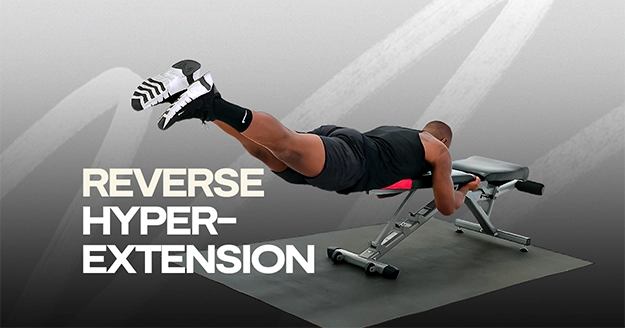Exercise Profile
Reverse Hyperextension Overview
The Reverse Hyperextension is a powerful exercise that works the glutes, hamstrings, and spinal erectors. It’s usually done on a reverse hyperextension machine or with a bench for support, making it an excellent choice for building lower body strength and improving spinal stability.
For beginners, the reverse hyperextension benefits are to build strength in the glutes and hamstrings while reducing stress on the lower back. Experienced athletes can boost the intensity by incorporating resistance bands or weights to maximize the engagement of the posterior chain.
This reverse hyperextension exercise can be incorporated into your lower body workouts for improved muscle activation or included in a core routine to enhance lower back stability and overall posterior muscle strength.

Reverse Hyperextension Instructions
Step 1: Lie face down on a flat bench, positioning your hips at the edge. Grab onto the sides of the bench for stability.
Step 2: There should be a 90-degree bend at the hips and knees. Ensure your knees and feet do not touch the ground.
Step 3: Extend your legs by kicking your feet back, fully extending your hips and knees. Engage your glutes to raise your legs until they are parallel the floor. You should feel the tension in your glutes rather than your lower back.
Step 4: Lower your legs under control until you return to the starting position.

Common Reverse Hyperextension Variations
Reverse hyperextension exercises strengthen your lower back, glutes, and hamstrings. Trying different variations can help target specific muscles while keeping your workouts more engaging and fun. Here are some common variations to adjust intensity and focus on different areas:
Reverse Hyperextension Tips
- Keeping proper form during the exercise is important, so concentrate on activating your glutes rather than relying on your lower back.
- Brace your core to help activate the glutes better.
- Begin with light aerobic exercise to warm up your muscles and prepare them for movement, ensuring they are fully engaged during your workout.
- Maintain a neutral spine throughout; focus on squeezing your glutes rather than arching your back.
Reverse Hyperextension Common Mistakes
- Lifting Too High: Raising the legs too high can cause lower back strain. Aim for a controlled lift where your legs are about parallel to the ground.
- Not Focusing on the Glutes: Shifting emphasis to the lower back instead of the glutes can limit effectiveness. Concentrate on using the glutes to perform the lift.
- Improper Setup: Positioning the body incorrectly on the equipment can affect balance and performance. Ensure a proper and stable set-up before starting the exercise.
Frequently Asked Questions
Is reverse hyperextension a safe workout?
Yes, reverse hyperextensions are usually safe. They effectively engage the lower back and glutes without overstressing the spine or hip joints. When performed correctly, they strengthen these muscles and lower the risk of lower body injury.
What weight should be used for reverse hypers?
For reverse hypers, start with a lightweight and increase as you get stronger. Aim for a weight that allows 8-12 reps with proper form—challenging but not too heavy. Always warm up and consult a fitness professional if unsure about your form.
Post your post-workout selfies in IG and tag @trainestapp, #trainest, or DM them to us to get a shoutout on Trainest Stories!


